With the wood fire warming the house, the labrador asleep on the hearth and Ebb the Spoodle snuggled up next to me, I look outside at the tall silver birch trees, their draping shapes further exposed with the leaves already fallen and I watch some little Silver Eyes skip between the branches. The fog is lifting across the valley and the sky is clearing, the sunshine is making the dew drops glisten on the ornamental Autumn Cherry branches. It is set to be a clear, crisp beautiful blue sky Tassie day.
I watch those tiny birds and think about how we have encouraged them into our garden, how when we came here the bird bath was covered in netting, there were no apparent signs of birds living in what was a very bare garden, they only visited. The fairy wrens lived in the neighbour’s hedge and the plover’s lived in the paddock across the road and visited our yard every afternoon at 4pm on the dot!
So how have we encouraged birds into our garden without feeding them?
Adding several bird baths to every part of our garden. eg. in our Kitchen Garden there are 8 bird baths, three traditional bird baths, some bird baths up high near the branches of trees and some at ground level. As simple as it sounds we always make sure they have water in them, on windy days they seem to empty very easily.
At one stage we did put some 100% peanut butter in the bough of the weeping ornamental cherry tree out our kitchen window, while the fairy wren’s loved it I was concerned about the long term health issues of them eating it daily. After all peanut butter is not part of a fairy wren’s natural diet. Our pup soon learnt where the peanut butter was and we would see him jumping up towards the tree trying to lick it, a very funny sight to see but the tree was suffering with the weight of the pup crashing against it.
Planting ornamental and native trees, plants and shrubs to encourage the birds has been wonderful, is there anything as lovely to do on a crisp Saturday afternoon then plant something. Trees and shrubs for the birds to nest in, rest in and eat from.
Leaving areas of the garden quite wild. Leaving the tall and leggy fennel to go to seed attracts insects which in turn gives the little birds something to eat when they land on the decomposing seed heads. We make sure not to trim the hedge when the birds are building their nests, sitting on eggs or have baby birds in their care.
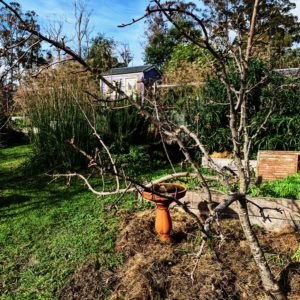
What is growing at the moment in our Kitchen Garden:
A bed of garlic.
A bed of winter greens, kale plants, silver beet, herbs, welsh onions and beetroot. Lots of soft feathery fennel fronds have started to shoot even though there are still fennel seeds to be harvested on the older stems of the plant.
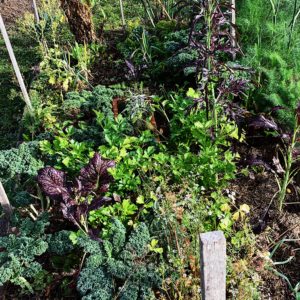
Another bed we have covered with about 20cm of soiled hay from the guinea pig hutches, I know that by the time I come to plant a summer crop that mulch will have returned to the earth, the soil will be rich and full of worms. (Note I never put soiled hay from the guinea pigs or poultry directly around vegetables.) Why so much mulch? It is a quick, economical solution for us, the garden bed had 6 golden nugget pumpkin plants growing in it last summer, each plant produced between 15-19 golden nugget pumpkins, that is a lot of pumpkin grown over a short space of time. The soil is well and truely depleted, desperately needing to be fed.
Sometimes the plan changes if something self seeds and it isn’t in the way, just like the kale and mustard greens that have self seeded where the plastic poly tunnel used to be, I’d rather adjust the plan instead of shifting it all.
There is some parsley & lettuce growing in cold frames. I am also trialing some spring onions in there as well, just to see how well they grow there in winter.
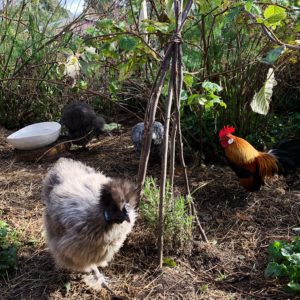
Enjoying the Winter sunshine. We prune last years growth closer to Spring time, it acts as a canopy for the little hens & Dutchie to fossick under. Camouflage/protection from the hawks.
The herb beds haven’t been pruned back yet, we’ll do that when it is closer to Spring. For the time being those branches that are dying off are protecting the new growth from frost, sheltering those tender new shoots that are starting to appear. It may look a bit scrappy but I would rather that then all those new shoots being exposed to the frost and wild windy weather we sometimes have.
About 6 weeks ago I noticed that a whole garden bed had become covered in tiny self seeded poppy seedlings, I may have turned a blind eye, those seedling have since grown, the winter plan for that bed got scrapped and I am now so excited at the prospect of a whole garden bed full of poppies. Doesn’t do much for our veggie growing but bloom where you are planted is my moto and of course that ties in with my theory that I can’t grow too many poppies.
Every year we deliberately grow kale and mustard greens for the hens. On our way to the Hen House we pick a handful and often hand feed them, reinforcing the trusting bond we have with them. It is a good chance for us to get up close to them and check for any health issues.
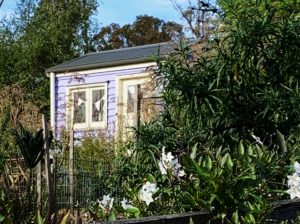
Michael mowed the lawn yesterday, just a quick trim, with the grass catcher on he collected just enough clippings to make a nice pile in the big Hen House for the little hens. Fossicking through the cut grass will keep them busy while they aren’t free ranging. Too many visits in our garden from birds of prey that have our little hens on their menu have us on guard during these colder months and we keep those sweet little poppets inside. I have designed the pen to accomodate this.
Previous years have taught me not to take my eye off the garden, it is part of natures cycle that never presses the pause button even though us humans do and with that in mind I am reminded again that each year we must continue to add plants, trees or shrubs to the garden in order to replace what hasn’t grown well from the previous growing season, to fertilise and mulch well. And so my mind turns to garden planning mode.
Happy gardening,
Jude x
Garden Planning
June 17, 2019
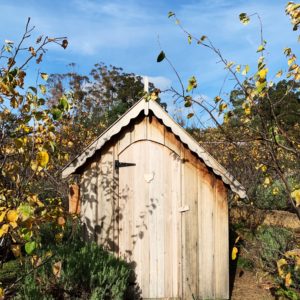
comments
share